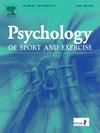篮球运动员工作记忆任务的正、负网络特征。
IF 3.3
2区 心理学
Q2 HOSPITALITY, LEISURE, SPORT & TOURISM
引用次数: 0
摘要
工作记忆(WM)在篮球等开放式技术运动中发挥着至关重要的作用。然而,运动诱导的WM适应是复杂的,潜在的神经机制仍然不清楚。本研究利用功能磁共振成像(fMRI)研究了55名篮球运动员和55名性别和年龄匹配的健康对照者在WM任务中的脑功能。结果表明,篮球运动员的任务正性网络(TPN)的激活增加,默认模式网络(DMN)的抑制激活减少,并且小脑介导的两个网络之间的新动态。这些神经适应与加速的反应速度相一致,以降低2回精度为代价,反映了针对运动特定需求优化的速度-精度权衡。未来的研究应该探索针对DMN调节和TPN参与的干预措施,以优化运动员的认知表现。通过连接运动神经科学和认知训练范例,这项研究为运动训练如何塑造大脑的功能结构提供了新的见解。本文章由计算机程序翻译,如有差异,请以英文原文为准。
Characteristics of positive and negative networks in working memory task of basketball athletes
Working memory (WM) plays a vital role in athletic performance in open-skill sports like basketball. However, sport-induced WM adaptation is complex, and the underlying neural mechanisms remain poorly characterized. Using an N-back task with fMRI, this study investigated the brain function of 55 basketball athletes and 55 gender- and age-matched healthy controls during the WM tasks. The results revealed that basketball athletes showed increased activation in the task-positive network (TPN), reduced inhibitory activation in the default mode network (DMN), and cerebellar-mediated new dynamic between the two networks. These neural adaptations aligned with accelerated response speed at the cost of reduced 2-back accuracy, reflecting a speed-accuracy trade-off optimized for sport-specific demands. Future research should explore interventions targeting DMN regulation alongside TPN engagement to optimize cognitive performance in athletes. By bridging sports neuroscience and cognitive training paradigms, this study offers new insights into how sports training sculpts the brain's functional architecture.
求助全文
通过发布文献求助,成功后即可免费获取论文全文。
去求助
来源期刊
CiteScore
6.40
自引率
5.90%
发文量
172
审稿时长
69 days
期刊介绍:
Psychology of Sport and Exercise is an international forum for scholarly reports in the psychology of sport and exercise, broadly defined. The journal is open to the use of diverse methodological approaches. Manuscripts that will be considered for publication will present results from high quality empirical research, systematic reviews, meta-analyses, commentaries concerning already published PSE papers or topics of general interest for PSE readers, protocol papers for trials, and reports of professional practice (which will need to demonstrate academic rigour and go beyond mere description). The CONSORT guidelines consort-statement need to be followed for protocol papers for trials; authors should present a flow diagramme and attach with their cover letter the CONSORT checklist. For meta-analysis, the PRISMA prisma-statement guidelines should be followed; authors should present a flow diagramme and attach with their cover letter the PRISMA checklist. For systematic reviews it is recommended that the PRISMA guidelines are followed, although it is not compulsory. Authors interested in submitting replications of published studies need to contact the Editors-in-Chief before they start their replication. We are not interested in manuscripts that aim to test the psychometric properties of an existing scale from English to another language, unless new validation methods are used which address previously unanswered research questions.

 求助内容:
求助内容: 应助结果提醒方式:
应助结果提醒方式:


